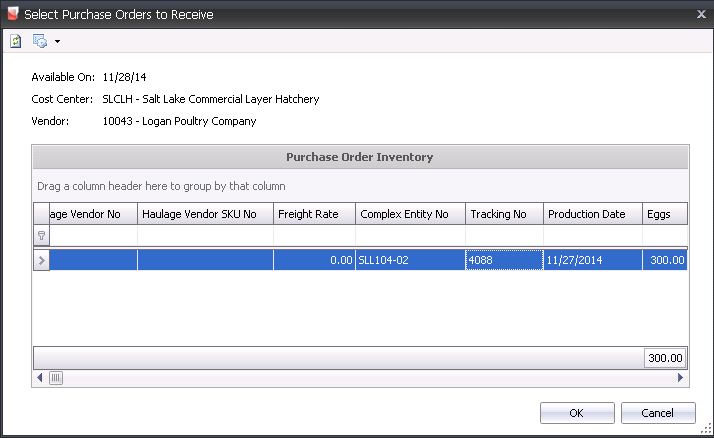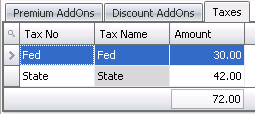

The Egg Room Receivings transaction is used to receive purchased eggs to the hatchery.
A Purchase Order must be completed and posted prior to the eggs being received to the hatchery. In addition to the purchase order, external entities must be defined to establish entity data for the eggs to be received. This process is handled in the LMTS>BIM>Master Data> Entities.
The following procedures are outlined in the Egg Room Receiving document:
The header contains the base data to outline the egg room receiving. The header is divided into two sections. The information in the Derived tab defaults in and is derived from the General tab.

The General tab contains the base data to outline the receiving.
 to create a new receiving transaction.
to create a new receiving transaction.From Vendor No, select the vendor that is supplying the eggs.
Location ID is an optional field to enter the location from which the vendor shipped the eggs.
From Haulage Vendor No, select the vendor that hauled the product if the purchase order had 'Excluded' or 'Delayed' freight selected. Alternatively, select the purchase order vendor.
In the Total Eggs field, enter the total number of eggs being received into the hatchery.
In the Notes field, enter any additional information relating to the receiving transaction.
Vendor Name displays the name of the vendor that is supplying the eggs.
Location Name displays the location from where the eggs are being shipped, if applicable.
Haulage Vendor Name displays the name of the vendor hauling the eggs.
The line details relate to the eggs that are being received from the vendor. The child grid for the line item also contains details related to add-ons and taxes. These amounts will default as defined from the purchase order and cannot be modified at receiving. If there is freight assigned to the product, two lines will appear in the details for each product received. The first line will be relating to the product details and amount ,with the second line referencing the freight amounts.
 to create a new line detail.
to create a new line detail.


Unit Description displays the unit of measure in which the product was purchased from the vendor.
Amount is a calculated field. Amount = Vendor Units x Unit Price.
Total Add-ons is a calculated total amount of premium add-ons that will be added to the vendor payment based on the amounts defined in the purchase order. Details are located in the child grid.
Total Discounts is a calculated total amount of discount add-ons that will be deducted from the vendor payment based on the amounts defined in the purchase order. Details are located in the child grid.
Taxes is a calculated amount based on the taxable product and/or add-ons as defined in the purchase order. Details are located in the child grid.
Total Amount is the calculated total amount of the receiving transaction based on the amounts that are defined in the purchase order.
Buggy No will indicate the buggy used if the eggs are received to a buggy.

Currency No defaults based on the currency assigned to the purchase order as defined, with no option to modify.
Currency Name displays a description of the currency type.
Select the Prepaid Final Receiving flag if the order was prepaid and this is the last delivery or receiving for the prepaid purchase order.
Within the Houses tab, there is a child grid with additional details relating to the receiving add-ons. The details will default from the purchase order.
The add-ons must be pre-defined in General>General>Products>AddOns prior to adding to the receiving transaction.
 on the Complex PO No field to display the child grid.
on the Complex PO No field to display the child grid.

Product Name displays a description of the add-on.
Transaction Basis is a read-only field that defaults from the selected add-on and determines how the add-on is calculated on orders. Options are: Per Unit, Percentage, Flat Rate, or Free Percentage.
Payment Type is a read-only field that derives from the purchase order and determines when the add-on payment is made.
Payee Type is an optional field that indicates the source type for the premium or discount add-on.
Transaction Entity ID is a required field if a different Payee Type is selected. If Payee Type is set, the selected vendor or cost center name will appear in this field.
Pay Calculation Type defaults from the vendor sku and determines the base amount of the add-on calculation.
Product Amount - the add-on is calculated based on only the product amount and does not include any other add-on in the calculation of the amount.
Net Amount - the add-ons is calculated based on the net amount of the transaction based on the product amount including other add-on amounts, but excluding taxes.
Normal - the add-on is calculated based on the rules established by Transaction Basis and the Payment Type defined in the vendor SKU and sales SKU.
Deduction Only - the add-on is calculated based on the rules established by Transaction Basis, however the add-on is only deducted from the vendor payment.
Taxable identifies if the item is taxable or non-taxable when the add-on is purchased. The flag will be selected if the item is taxable.
Currency No defaults based on the currency assigned to the purchase order as defined, with no option to modify.
Currency Name displays a description of the currency type.
Rate displays the total cost of the add-on.
If the eggs and/or premiums/discounts are taxable, the tax code must be assigned on the Taxes tab. The tax amount will then be calculated based on the taxable order amounts. Tax codes as defined on the purchase order will default to the receiving transaction. The amount will be calculated based on the rate that is in effect on the receiving date. There are two types of taxes.
Accrual Taxes - will record the tax accrual and record the journal transaction at time of receipt.
Invoice Taxes - will calculate the tax at time of receipt, however, the journal transaction is not created until the purchase invoice is processed. Invoice taxes are generally used for federal taxes that are reimbursed to the company by the government and cannot be actually recorded until vendor invoice is received.

Tax No identifies the tax code to be applied to the product and premiums/discounts for the selected line item. The Taxable flag must be selected in the product and premiums/discounts for taxes to calculate.
Tax Name describes the selected tax code.
Amount is the total amount of tax applicable on the product.
Once the egg room receiving transaction is saved and closed, the transaction can be posted. The posting process locks the transaction to prevent edits, and will also create the journal transaction to record the amounts for receiving. Once posted, the product will be displayed in inventory at the recorded value.
 in the top menu bar and select 'Post'.
in the top menu bar and select 'Post'.The journal transaction is created to debit the egg room inventory of the hatchery and credit the accounts payable.